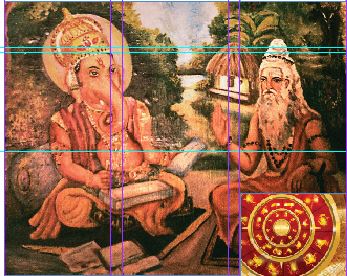Astrology is the eye of the Vedas is like a guiding light that can show ypu the direction when you seem to lose hope, or you are confused are not sure. Astrology is a science that helps to understand how the planetary movements are changing or shaping our life. The subject of astrology, or Jyotish, is as ancient as the Vedas themselves. In ancient times, the study of celestial bodies such as planets, stars, and other astronomical objects was referred to as Jyotish. The mathematical aspects of astrology are clearly mentioned in the Vedas, while information about predictive astrology came much later.
The antiquity of Indian Astrology The knowledge of astrology among the ancient Aryans dates back to extremely ancient times. The purpose of this knowledge was to determine the dates of rituals and ceremonies. The movement of the equinoxes is mentioned in the Vedic scriptures. For example, Punarvasu to Mrigashira (Rigveda), Mrigashira to Rohini (Aitareya Brahmana), Rohini to Krittika (Taittiriya Samhita), Krittika to Bharani (Vedanga Jyotisha). It is known from the Taittiriya Samhita that in ancient times, the vernal equinox fell in the Krittika Nakshatra. The commencement of the Vedic year was considered from this vernal equinox, but the calculation of the equinox was done from the month of Magha.
After this, the year’s calculation began from the Sharad equinox. Both these types of calculations are found in the Vedic scriptures. In Vedic times, the vernal equinox sometimes fell in the Mrigashira Nakshatra as well. This has been proven by Bal Gangadhar Tilak with evidence from the Rigveda. Some people have determined that the position of the vernal equinox was 4000 years before Christ. Therefore, there is no doubt that Hindus had knowledge of concepts like equinoxes long before 5-6 thousand years ago, and they used to prepare horoscopes for rituals. The name of the first month of the Sharad season was Agrahayana, whose full moon fell in the Mrigashira Nakshatra. This is why Krishna said in the Gita, ‘Among months, I am Margashirsha.’
Due to being a part of the Vedas, astrology was known as Vedanga during this time. In this era, 18 sages made significant contributions to the development of astrology. The names of these eighteen sages are Surya, Pitamaha, Vyasa, Vashishtha, Atri, Parashara, Kashyapa, Narada, Garga, Marichi, Manu, Angira, Pulasya, Lomasha, Chavana, Yavana, Bhrigu, Shaunaka.
It is believed that Sage Bhrigu, who predicted the future through astrology, was the first to do so in the world. With the help of Lord Ganesha, he created approximately 500,000 horoscopes. However, only some portions of the scriptures written by Maharishi Bhrigu are available.
Contemporary astrologers rely on the “Brihat Parashara Hora Shastra” written by Sage Parashara for predicting the future. This scripture of astrology describes the characteristics of planets, constellations, yogas, marakas (death-inflicting factors), kalachakra (time cycles), antardasha (sub-periods), and dasha chakra (main periods). Based on these, astrologers predict people’s futures by examining their horoscopes.
Our ancient Vedas give utmost importance to Mother Earth first and then discuss space, the heavens, the sun, the moon, the constellations (27 Nakshatras), water, herbs, plants, wandering celestial bodies (nine planets), living beings, and the animate world. Therefore, we find evidence from the Vedas that the most important planet in astrology is Earth.
In ancient times, calculations were done from Lanka or Ujjain. Indian astrologers used to consider the Earth as the center for calculations and determined the precise position or motion of the planets.
This differs from today’s calculations regarding the orbits of planets, etc. The zodiac was first divided into 28 Nakshatras. The division of signs came later. The names of the zodiac signs are not found in the Vedic scriptures. These zodiac signs have no connection with rituals. Many scholars believe that the names of the signs and days were derived from the Greeks. Several technical terms have also been taken from the Greeks, such as hora, drakkana kendra, etc.
Description of astrology in ancient Vedas, The Vedas are considered apauruṣeya, meaning they are without human authorship and are considered to be the words of God. They are also called shruti. Other texts like the Smritis are based on human intellect or are knowledge based on shruti. The knowledge related to astrology is found in the Vedas, with approximately 30 verses in the Rigveda, about 44 in the Yajurveda, and about 162 in the Atharvaveda. The ancient architectural text “Sthapatyaveda” is also taken from the Atharvaveda, which contains knowledge related to architecture. The most important thing to note is that while the Vedas contain prayers related to constellations, planets, and zodiac signs, there is no predictive astrology described in them.
The Vedas state that auspicious and successful present and future are created through your thoughts, energy, abilities, deeds, and prayers. The name of this astrology knowledge is Vedic astrology because its origin is from the Vedas. There are four Vedas, among which the Rigveda is the most ancient. There are about 30 verses related to astrology in the Rigveda, about 45 in the Yajurveda, and about 162 in the Atharvaveda.
Historians have different opinions about the Vedic period. Max Muller considers it merely from 1200 BCE to 600 BCE. Whereas Avinash Chandra Das and Pavagi believe that the Vedic period is much older than that. Despite this difference of opinion, it is believed that our sages had already gained knowledge of astrology before the Vedic period. They had learned to calculate time and determine auspicious and inauspicious times.
According to the Narada Purana, the knowledge of astrology was received by Narada from Brahma. There is no mention in this Purana of how this knowledge reached other sages. Due to this knowledge, Narada was revered among both gods and demons. The period from 8300 BCE to 3000 BCE is considered the golden age of astrology. During this period, many important researches were conducted on astrology. By the end of this period, astrology had developed scientifically.
Dr. Amit Vyas, Astrologer and Vastu expert







